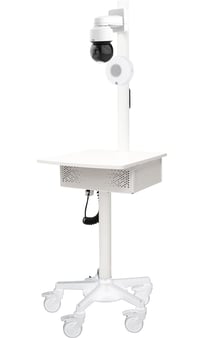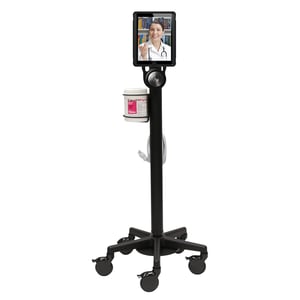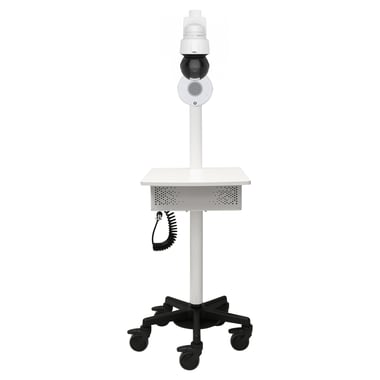By First Products on 12/1/21 10:50 AM
Falls and Patient related falls & fall-associated injuries continue to add to the cost of healthcare across the United States.
To prevent their occurrence, acute care providers have traditionally assigned individual bedsitters to provide in-room support and monitoring for at-risk patients. But because of ongoing budget cuts and staffing shortages, many facilities have found that this approach is no longer sustainable.
For that reason, a growing number have begun replacing at least some in-room bedsitters with virtual sitter video monitoring systems that allow a single remote observer to monitor multiple at-risk patients simultaneously.
In-Hospital Falls: The Scope of the Problem
According to the U.S. Agency on Healthcare Research and Quality, between 700,000 and 1 million in-patients fall while hospitalized every year. Roughly 30% to 50% of those incidents result in fall-related injuries, including bone fractures, subdural hematoma, and severe bleeding.
Up to 20,000 patients die annually due to complications associated with an in-hospital fall.
Treating fall-related injuries costs U.S. hospitals around $14,000 per fall. And because Medicare no longer provides reimbursement for this care, the costs associated with falls and fall-related injuries can quickly add up to a significant unbudgeted expense for an already struggling facility.
The Bedsitting Approach to Hospital Fall Prevention
Patients fall for many reasons. Some have dementia or neurological problems that make them more likely to fall, even when they're moving about with staff assistance. Others fall because of behavior issues that cause them to act out. In some cases, environmental factors, such as slippery floors or electrical cords and other obstructions – will cause even low-risk patients to fall in the hospital.

Whatever the reason, healthcare facilities are required to take steps to mitigate risks and reduce the likelihood of falls and fall-related injuries. For decades, in-room bedsitters have been assigned to prevent falls and other adverse events among high-risk patients. In such a case, a patient attempting to leave their bed would be redirected by their sitter, who could also alert nursing staff when necessary. Bedsitters are also trained to respond to patient needs by following specific hospital protocols. For example, a sitter might verbally respond to a disoriented patient, answering their questions and providing reassurance.
.jpg?width=300&name=Copy%20of%202%20(1).jpg) In-room bedsitters help keep patients safe and free nurses and other clinical staff to deliver patient care, but these benefits come at a significant cost. In 2013, the non-nursing staff that typically performed bedsitting duties earned an average wage of $10.67. While bedsitters' pay continues to lag behind nursing staff wages, those costs are non-reimbursable and quickly run into the millions of dollars over a single fiscal year.
In-room bedsitters help keep patients safe and free nurses and other clinical staff to deliver patient care, but these benefits come at a significant cost. In 2013, the non-nursing staff that typically performed bedsitting duties earned an average wage of $10.67. While bedsitters' pay continues to lag behind nursing staff wages, those costs are non-reimbursable and quickly run into the millions of dollars over a single fiscal year.
How Does Virtual Sitter Video Monitoring Work?
Improvements in telehealth technology have helped hospitals expand access in rural areas, address a growing physician shortage, improve workflows, and achieve cost efficiencies. Those same technologies have also made virtual sitter video monitoring systems a viable approach to fall prevention. These systems consist of cameras positioned in patient rooms – either hard-mounted to the walls or attached to portable telesitter carts – that provide real-time, continuous visuals to a trained staff member assigned to a remote workstation. The cameras pan and pivot, ensuring a clear view of each patient from anywhere in their hospital room, while two-way audio and visual feeds allow the remote observer to communicate with their charges, providing support and redirection as needed.
These systems consist of cameras positioned in patient rooms – either hard-mounted to the walls or attached to portable telesitter carts – that provide real-time, continuous visuals to a trained staff member assigned to a remote workstation. The cameras pan and pivot, ensuring a clear view of each patient from anywhere in their hospital room, while two-way audio and visual feeds allow the remote observer to communicate with their charges, providing support and redirection as needed.
Virtual sitter systems also include an alarm that allows the observer to notify nursing staff when a patient requires help. Some can even be configured to provide remote control of in-room medical and monitoring devices. The system documents all alerts, and every incident and behavioral change are noted in each patient’s chart to ensure effective communication across the entire care team..jpg?width=842&name=CC-0013-01_Mov-itTelesitterCart_Hospital%20Nurse%20and%20Patient%20(1).jpg)
Can Virtual Sitters Effectively Prevent Falls?
Hospitals that have transitioned to virtual sitter video monitoring have reported very encouraging results. For example, Northern Westchester Hospital in upstate New York reduced in-patient falls by 54% once its telesitter program was up and running.
TIRR Memorial Hermann in Houston, Texas, saw a 9% reduction in falls and a 51% reduction in staff injuries related to brain-injured patients. Another upstate New York provider, Sunnyview Rehabilitation Hospital in Schenectady, reported 20% fewer falls once it made the switch. Virtual sitters were also associated with significant cost savings at all three facilities. But the benefits of virtual sitter video monitoring go well beyond cost efficiencies and fall prevention. For one thing, families have the comfort of knowing someone is continuously looking out for their loved one when they’re most vulnerable. These systems can also help prevent suicides and discourage illicit drug use, violence against staff, and other dangerous behaviors. Finally, the data collected by virtual sitter technology can be leveraged by hospitals to identify and address any areas that need improvement.
reduction in staff injuries related to brain-injured patients. Another upstate New York provider, Sunnyview Rehabilitation Hospital in Schenectady, reported 20% fewer falls once it made the switch. Virtual sitters were also associated with significant cost savings at all three facilities. But the benefits of virtual sitter video monitoring go well beyond cost efficiencies and fall prevention. For one thing, families have the comfort of knowing someone is continuously looking out for their loved one when they’re most vulnerable. These systems can also help prevent suicides and discourage illicit drug use, violence against staff, and other dangerous behaviors. Finally, the data collected by virtual sitter technology can be leveraged by hospitals to identify and address any areas that need improvement.
It is essential to understand that, despite their numerous advantages, virtual sitters can’t replace standard safety practices, such as providing non-slip socks, proper lighting, and ensuring patient belongings are kept within their reach. Neither are these systems appropriate for every patient. For example, the Cincinnati VA Hospital has continued to utilize in-room bedsitters to monitor certain patients ---those considered homicidal, who have known suicide risks, or who are hard-of-hearing -- even after implementing a very successful video monitoring program for other at-risk individuals.
First Products: Telesitter Cart Solutions for Virtual Sitter Video Monitoring
First Products is ready to partner with your team to ensure the success of its virtual sitter video monitoring program. From telesitter carts and mounts like the TeleView™️ 2-way telemonitoring cart to tablet roll stands, our perfect-fit solutions are designed to make the most of today’s digital healthcare revolution.
We've been helping medical professionals and acute care facilities improve patient access, satisfaction, and outcomes for more than 50 years. Our unparalleled commitment to customer service, highly experienced sales support, dedication to long-term customer satisfaction, and industry-best warranties have earned First Products the trust and respect of providers throughout the United States and across the globe. To learn more about how our perfect-fit telehealth solutions can help your facility reduce falls and improve overall patient safety, please contact: First Products at 800.854.8304 to arrange for your COMPLIMENTARY DEMO today.
To learn more about how our perfect-fit telehealth solutions can help your facility reduce falls and improve overall patient safety, please contact: First Products at 800.854.8304 to arrange for your COMPLIMENTARY DEMO today.
_11wX8.5h-FINAL.png?width=721&name=FP-Logo-Horizontal-(COLOR)_11wX8.5h-FINAL.png)


comments